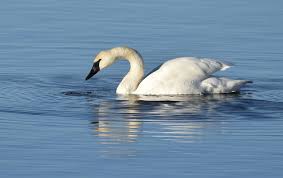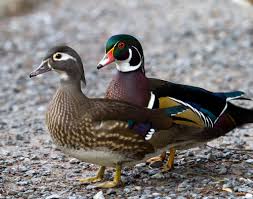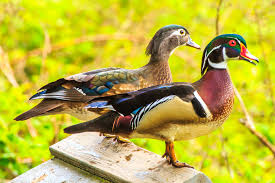Waterfowl of the St. Croix River Valley
- Cecilia Gustafson
- Aug 27
- 4 min read
What even is a waterfowl?
A waterfowl is a bird belonging to the Anatidae family, typically categorized by birds that live and rely on bodies of water. This includes ducks, geese, and swans. Waterfowl species within the St. Croix Valley include trumpeter swans, common loons, and many types of ducks. Read on to learn more about some of our staff favorites!
Mallard Duck (Anas platyrhynchos): The mallard duck is a very common species in the St. Croix watershed. They are known for the male's vibrant green head and yellow bill while females are brown. Both the male (drake) and the female (hen) have purple-blue wing patches. Mallards are omnivores, and their diet consists mostly of seeds, plant matter, and small insects and worms. They are dabblers, meaning they skim the water for food rather than diving completely into the water. They are the most common duck in the United States and can be found throughout the country.
Fun Fact: The iconic “quack” of a duck is not made by all types of ducks. In the case of mallards, only the females quack; males do not make much noise at all, just an occasional raspy call.

Tundra (Cygnus columbianus) and Trumpeter (Cygnus buccinator) Swans: Do you know the difference between these two species? Next time you see a swan, look to see if it has a yellow spot at the base of its black bill, and is it smaller than the usual swans you see? If yes, then you're looking at a tundra swan! These beauties are usually eat aquatic vegetation, although they can be spotted eating crops like corn and barley during the winter months. They migrate from the Arctic every year so keep an eye out for them this fall and winter because they're on their way here!
If it's summer and you spot a swan, you're likely looking at a trumpeter swan. Unlike tundra swans, trumpeters live in the St. Croix Valley year-round. They're our biggest and heaviest native waterfowl (and certainly one of the loudest). They are purely black and white so you shouldn't see any yellow on these waterfowl - if you do, you're likely looking at a tundra swan.
Fun fact: These swans find life-long mates at around 3 years of age and typically have clutches of 3-6 eggs. The term for baby swans is flappers or cygnets, which parents carry around on their backs for protection.
Tundra Swan (Left) - Trumpeter Swan (Right)
Wood Duck (Aix sponsa): Beauty may be in the eye of the beholder, but most St. Croix Valley residents would agree that the wood duck is one beautiful waterfowl. Male wood ducks are known for their crested heads, adorned with an array of colors, including iridescent green, blue, purple, and a vibrant red bill. Females don't need to be so showy so they lack the colors of the males. Instead, they are smokey gray with white circles around the eyes.
Wood ducks are perching ducks and can be found nesting in tree cavities along wetlands and rivers or resting on branches. Their diet consists mostly of tree seeds and includes invertebrates and aquatic plant matter during the summer months.
Fun Fact: Since wood ducks are cavity-nesting birds, they need cavity habitat for successful breeding. Landowners can help wood ducks by keeping standing, dead trees on their property, especially near water. Alternatively, landowners can purchase or build predator-resistant nest boxes here.
Female Wood Duck (Brown) - Male Wood Duck (Colorful)
Common Loon (Gavia immer): If you have ever camped by the waters of the St. Croix Valley, you've likely heard the eerie call of a loon. Loons have four types of calls: yodels, hoots, tremolos and wails, which each serve a different purpose, such as warning calls and communicating with young & mates. Despite the loon's tendency to scare campers at night, the common loon is so well-loved that it was chosen as Minnesota’s state bird. This could be because the loon is a striking bird - they have black heads and bills, black with white spots on their backs, a white breast, and red eyes. Or perhaps they were chosen because they are skilled predators that use their thick, sharp bills to prey on small fish and aquatic crustaceans as they dive through the water. Or maybe it's because they are a sign of a healthy waterway since they need clear water to hunt successfully. Regardless of the reason, loons are unique birds that the St. Croix Valley is lucky to have as year-round residents!
Fun Fact: Unlike most birds, loons have solid bones to help them dive through the water. They're so well adapted for water that you will rarely see them on land unless they are nesting or stranded. Loons sometimes get confused after rain events and will land on roads that are shiny with water. This can be a real issue for the stranded loons because they need a long stretch of deep water to take off for flight. If they are unable to get back to a waterbody, they will be stuck without food or the ability to migrate.

A Common Loon Swimming Ring-Necked Ducks (Aythya collaris): Ring-necked ducks can be found in the St. Croix Valley in both migration and breeding season. Keep an eye on shallow areas because these diving ducks can often be found feeding and nesting in shallow water, unlike other diving species. They have a diverse diet, eating aquatic plants, mollusks, snails, and insects. Several hundred thousand of these ducks will congregate each fall on certain lakes in Minnesota to feed on wild rice.
Fun Fact: Despite the name ring-necked duck, there is no easily discernible ring on the neck of these ducks. Look for the peaked plumage on the head and the gray, white, and black stripes on the bill instead to identify these birds in the wild. The male bodies tend to be a gleaming black, gray, and white, whereas the females are brown.

Male Ring-Necked Duck (Left) - Female Ring-Necked Duck (Right)

.png)







Comments